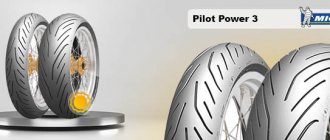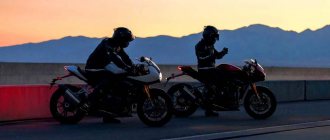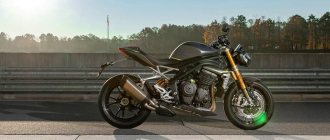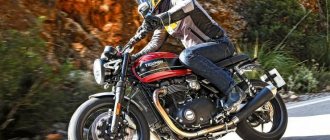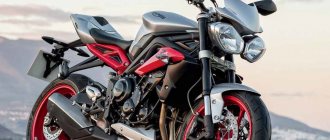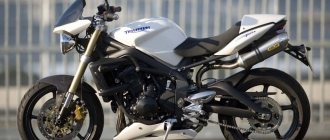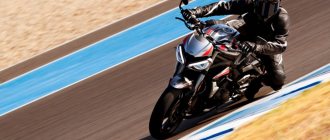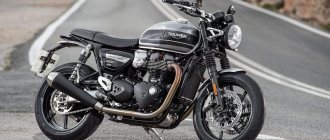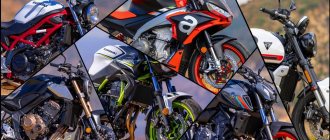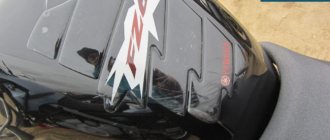Delivery to any city in Russia, Belarus and Kazakhstan. New motorcycle from an official dealer. Official warranty for the motorcycle is 2 years without mileage limitation.
BEST SPEED TRIPLE
In 2022, the 1200 RS revolutionizes the ultimate naked bike class. It was a revolution in power, weight, performance, handling, design and technology. Now in 2022 the bar has been raised even higher.
The new Speed Triple 1200 RR is designed to offer even higher levels of performance, rideability and style. This is the best Speed Triple in the history of the model.
NEXT LEVEL More sophisticated, with first-class equipment, the RR features a sleek new half-fairing, sporty clip-on steering wheel and even more refined ergonomics. With the latest technology, top-of-the-line suspension components, and premium brakes and tires, the Speed Triple 1200 RR is as capable on the road as it is on the race track.
SPEED TRIPLE 1200 RR EQUIPMENT
ENGINE
- 1160 cm3 3-cylinder engine, designed from scratch based on the experience of the Moto2 sports program
- Power 180 hp at 10,750 rpm
- The maximum torque is 125 Nm at 9000 rpm
- Redesigned gearbox
- Double sided quickshifter
- Slipper type clutch
- Exhaust system with an even lower and more distinctive sound
FRAME AND SUSPENSION
- Lightweight aluminum alloy frame
- Ohlins inverted fork with electronic rebound and compression adjustments, 43 mm diameter and 120 mm travel. Öhlins S-EC 2.0 OBTi system
- Ohlins monoshock absorber with electronic rebound and compression adjustments, rear wheel travel - 120 mm. Öhlins S-EC 2.0 OBTi system
- Alloy wheels
- Pirelli Diablo Supercorsa V3 tires
- Powerful brakes: Double disc brakes with BREMBO Stylema monobloc radial calipers
- Brembo MCS front brake lever with position and force adjustment and clutch lever with adjustment
EQUIPMENT AND TECHNOLOGY
- Color 5" TFT instrument panel
- Bluetooth module integrated into the dashboard
- My Triumph system (phone, music, GoPro and turn-by-turn navigation)
- Illuminated steering wheel switches and 5-way joystick controls
- Cruise control
- ABS system and stability control system, taking into account the angle of inclination of the motorcycle
- Front wheel lift control systems
- System for keyless starting of a motorcycle, opening the fuel tank and locking the steering column
- 3 fuel maps, 4 stability control modes, 5 programmable motorcycle operating modes: Road, Rain, Sport, Rider, Track
- Full LED headlight and other lighting optics
STYLE
- Front sleek half-fairing
- Plastic cover for passenger seat in motorcycle color
- Mirrors on the front fairing
- Carbon fiber front fender
ERGONOMICS
- Sports ergonomics
- Steering wheel on clip-ons
WARRANTY AND SERVICE
- Two years warranty without mileage limitation
- Service-to-service mileage 16,000 km
Triumph Tiger 955i - who is it?
Hello again everyone!
Since the last entry, my Saber, nicknamed Ognetank, has successfully found a new home, and I continued my search to buy a motorcycle for a long-cherished idea - “tipaturenduro”. I was faced with a rather non-trivial task - to find a tourist with the skills for bad roads, so that it fit into a fairly modest budget of 350-380 thousand. If you are now faced with the same choice, I will be happy to share some of my experience:
1. Honda XL700V Transalp 700.
Why 700? All the endurists I knew unanimously told me “it has small wheels, it’s better to take the 650, it’s easier to maintain and off-road.” But hey! I'm looking for a tourist with suspension, not an enduro with tourism. The 700 is the least enduristic bike of the entire line. Its significant advantages:
- large suspension travel (177/173)
- injector
- ABS
However, it has 60 hp, which is even slightly less than on my Ognetank and does not have a 6th gear. That means I'll still have a cruiser around 120. Not that I'm looking for top speed, but being able to do a quick lead or overtake would be nice. It’s not that it’s deprived of wind protection, there’s even something like stampings on the tank, but I wouldn’t say it’s strong. Let's consider it average. The engine, let me remind you, is V-twin and although this is “true”, it’s not a fact that I won’t get the same problem as myself - vibrations where I don’t need them. For 400 thousand you could buy a 2012 model with a mileage of about 18 thousand km. Quite worthy.
Bottom line: more enduro than tourist, but also not very enduro (650-600 is supposed to be better, although older)
2. Honda XL1000 Varadero
Speaking about Varader, the first thing worth mentioning is that in 2003 there was a significant modification that added a 6th gear and an injector, I will talk about it. Having become a continuation of the Transalps line, the Varadera has become an even more road (and more touring) bike. This is clearly evidenced by the cast wheels (which every endurist considers a death sentence) and powerful wind protection. However, the liter V-shaped engine from the VTR1000F, which has 94 horsepower at 8000 rpm, tells us not only that it will trample, but also that it will buzz quite a bit) Total advantages:
- 6 gears
- injector
- powerful motor
- good wind protection
- capacious tank (25 liters)
In turn, the disadvantages include both cast wheels (although this is debatable, I fell into holes but did not damage my casting) and the shorter suspension travel compared to the translator - 155/145. I won’t lie, this motorcycle remained a favorite until the very end. Having the above budget, you can find a device from 2004-2005. in good condition.
3. BMW R1150GS
Strictly speaking, BMW is somewhat outside the budget - finding a live device within 400 thousand is a huge success. Bekha competently combines such advantages as:
- 6 gears
- injector
- large suspension travel (190/200)
- good wind protection
- powerful motor
- cardan
with the only drawback - such devices, when they appeared rarely, sold like hot cakes. The chance of running into a living dead here is greater than ever - buyers, inspired by the coveted blue-and-white nameplate, often turned off their brains. In general, the option was good except for the fact that in general it did not exist. And to be honest, a “goose”, even an old one, should be put on a par with a “pimp” or a new tiger, but not in our modest budget. For 450 it’s a different matter)
4.Yamaha TDM-850
You either love tydym or you don't. At least this is the feeling I got from testing the waters on this topic. So, we have 850 cubes in an in-line two, 83 horsepower, suspension travel 150/133 and a weak windshield as wind protection. No offense to the smoke ducts, but I don’t understand how it relates to my task at all and why it was recommended to me - it’s a good road worker, yes, but it’s not really a tourist and I wouldn’t call the suspension travel great either.
5. V-strom, etc.
It would be dishonest not to point out the fact that there are other entry-level SUVs of varying degrees of “endurance” or “touring” - the legendary Honda Africa Twin, Suzuki V-strom, Yamaha Tenere, Kawasaki KLR650 and maybe others. But I simply did not consider all of them for various objective and not so objective reasons.
6. Triumph Tiger 955i
This option appeared already when the budget was formed, and I was once again looking at sites selling models 1-3. It turned out that this pepelats was being sold by a friend. What are our advantages:
- 6 gears
- injector
- large suspension travel (230/230)
- average wind protection
- powerful motor
Hmm, “except for the cardan, it’s a goose,” you’ll say, and you won’t be entirely right. Because read, I write in more detail. There is very little information about this moto on the RuNet ! And I will, to the best of my ability, add everything that I dig up to the journal, so that it will be easier for everyone. So:
TRIUMPH TIGER 955I
ENGINE
This modification dates back to 2001, when Triumph introduced an updated 955 cc engine, also intended for Trident and Daytona. The inline three is an unusual engine. While sports, with rare exceptions, take 4k, enduro uses 1 or 2 cylinders, it is completely unclear what to expect from 3k.
Technically, we have 955 cubic meters, 3 cylinders 79*65mm, DOHC 4 valves per cylinder, compression 11.6:1, liquid cooling, injector. At the same time, we get the maximum herd of 104 peppy English mares at 9500 rpm, but the maximum torque of 92 Nm is at 4400 rpm.
In fact, we have a motor that pulls consistently from 1500 rpm to the red zone. Moreover, if you accelerate from the same 1500, then after 4000-4500 you feel even greater acceleration. And it’s clear why. That is, of course, the power curve is not flat, but the range of operation of the motor is impressive.
As part of the comparison, Goose has 85 hp. at 6750 rpm and 98 Nm at 5250 rpm. That is, the Tiger loses somewhat in terms of momentum, winning in horses. Not surprising given this engine configuration.
SUSPENSION
230 front, 230 rear. Just think about these numbers. The suspension travel is gigantic. Not only do road bumps simply cease to exist, speed bumps also become a bit of a misunderstanding in the city, as well as probably curbs, tram tracks and off-leash Chihuahuas.
While winning in terms of suspension travel (190/200 for Goose), the Tiger, of course, loses to Telelever and Paralever technologies.
BOX
The clutch is multi-plate, wet. I don’t remember the data on Goose and I couldn’t find it right away, but I wouldn’t say that it makes sense to compare anything here - both systems have their pros and cons. Both motorcycles have 6 gears, but the gear ratios may differ.
So, at 1500 rpm idle (I haven’t figured it out yet, maybe less is possible - the engine runs smoothly at 1000) the Tiger in 1st gear will roll about 10 km/h, which is not very conducive to “crawling” through traffic jams. On the other hand, these giants were not made for the city at all, and on my firetank the 1st gear was frankly short. Right there on the 1st you can “push it up” to about 60.
I didn’t have a chance to ride the 1150, so again I can’t compare.
MAIN GEAR
The tiger has a chain, X-ring. Of course, from the point of view of a lazy person, a cardan is more convenient, but if it breaks, you will have huge problems. On a cruiser, I would raise both hands by the cardan (I rode with a cardan), for a tourenduro, I think a lot depends on where and how the motorcycle will be used. The chain takes less power and reduces unsprung weight. And thanks to the stars, the gear ratio can be slightly changed. At the same time, the cardan does not get dusty in the steppes and does not require regular lubrication and maintenance. In general, decide for yourself) Draw.
BRAKES
Here the victory definitely goes to Goose - 320 versus 310 for the Tiger, in addition, 4-piston versus 2-piston calipers, and also ABS, which the Tiger does not have. At the same time, the rear is 276 versus 285 for the Tiger.
The weight of the devices is approximately comparable, so it is impossible to say that more powerful brakes are due to greater weight.
MORE FIGURES
Acceleration 0-100 is 3.9 seconds versus 4.3 for Goose. I can’t imagine these two getting into drag.
The maximum speed is 206.5 versus 194 for Goose. Apparently in the same world as drag.
TOURISM
Here it is perhaps more detailed. If our goal is tourism, it would be nice to evaluate the key parameters for this. We have no problems with load capacity, unevenness and nonsense, but what about fuel consumption, tank capacity and wind protection?
The claimed consumption of the Tiger is 5.6 l/100 km. For the BMW R1150GS, this is “from 4.5 liters (at a speed of 90 km/h) to 5.7 liters (at a speed of 120 km/h) per 100 km.” Of course, you and I understand perfectly well that this was the case in 2005 after the run-in, so I would estimate 6-7 liters for both units.
The Tiger's tank is 24 liters, the BMW's is 21 or 30, depending on the modification. This will give us 350+ km on one gas station for any option, but I am ready to authoritatively declare that my ass will get tired sooner. Unlike Ognetank, here you can get up and drive standing for a while, but my girlfriend will kill me first))
With wind protection it’s much more interesting:
Having a similar height of the windshield, the motorcycles are radically different in their approach to protecting the pilot’s legs. In the case of the Tiger, wind protection is somehow provided only by the air flow from the muzzle and the sides of the tank, while with the Goose you get effective protection from both the tank and the cylinders. However, everything has its drawbacks - the 1150 is an air motor and the warm air of the underworld will blow on your legs in heavy traffic.
FIRST IMPRESSIONS OF THE TRIGGER
Oh yeah, I forgot to say. Due to the fact that after 4-5k we get to a large amount of power even more, it’s as if we switched to sports and in view of crossing out unnecessary letters. In Triumph Tiger, I call this moto “Trigger”. So, he's off. No, he's GOING . The pendants swallow everything without a second thought - they were intended for much more serious tasks.
There have never been any problems with handling - honestly, it was as if I had ridden it. It falls and comes out of a turn absolutely predictably; the tires were also pleasing. The gears click powerfully and clearly, although compared to the Honda gearbox there is a peculiarity - if you are in 1st, then the Honda’s paw will be half pressed down and then that’s it - there’s nowhere to go. And here, if you stuck the first one in, then the paw is only up - no down.
No glitches with the neutral light were noticed, nor with the neutral itself. There is a small complaint about the indicator lamps - they could have been brighter. The instrument lighting is what you need; the main instruments include an odometer, speedometer, revolutions, gasoline and temperature. The main ones are in the sense of arrows. Well, there are a bunch of additional lights, for example for oil pressure or the same turn signals.
The weak point of the model is considered to be the generator - since the motor from a sport was stuffed into a touring enduro, the typical owner turns the engine a little, and uses a lot of consumers. As a result - undercharging and more frequent death of Akuma. I got the device with a battery that died over the winter, and judging by the voltmeter, my friend did not deceive me - everything is in order with the RR and the generator. Plus, last year the generator was rewinded to increase power, but the battery was not changed.
Speaking about consumers, the owner talked about the standard heated handles. Indeed, a huge button is present on the left panel, has 3 positions and a handle and waves icon. It’s just that this heating didn’t last long enough for me, so it’s just like normal. Heats up just fine too. And the fog lights are turned on by a button.
The head light left a strange impression - obviously 2 headlights are better than 1, but I’m not used to yellow light (the previous owner installed such lamps) so it’s difficult to evaluate its effectiveness. But what stands out in the stream is for sure.
The brakes (obviously) are much more effective than mine, which causes involuntary puzzled glances at Honda - after all, even Yamaha on the Dragstar has 2 discs in front, and I had 1. In addition to efficiency, there is a noticeable nose dive - on cruisers it is not particularly felt, on there are more on roads, and here it is also reinforced by large suspension travels. In general, you need to get used to the new brakes, but the fact that they are better is for sure.
The last point arising from the large suspension travel is the high seating position. No, in itself it does not cause any inconvenience - a classic, “straight” landing. It’s just that, at my height of 185, I can reach the ground with my full feet only with my legs fully straightened. This, in particular, means that in order to push the bike forward or backward while sitting in the saddle, effort is required that I do not have. If you get off the motorcycle, it rides even a little easier than mine - the steering wheel is not as strong. The main thing is not to tilt it too much, otherwise the same 200+ kg that Ognetank had somewhere below is much higher here and will say their ardent greetings to you right there. There is a central stand, but I don’t have the skill to put it on)
The mot has been successfully registered to me, so I’m stopping my post here, otherwise there’s already a wall of text. See you)
ENGINE AND TRANSMISSION
ENGINE TYPE 3-cylinder in-line liquid cooled, 12 valves, DOHC
ENGINE CAPACITY 1160 cm3
CYLINDER DIAMETER 90 mm
STROKE 60.8 mm
COMPRESSION RATIO 13.2:1
POWER 180 hp (132.4 kW) at 10,750 rpm
TORQUE 125 Nm at 9000 rpm
INJECTION SYSTEM Multipoint electronic injection with electronic throttle control
EXHAUST SYSTEM Stainless steel, type 3 in 1
WHEEL DRIVE X-ring chain
CLUTCH Multi-disc in oil bath
GEARBOX 6-speed
Engine
The new 1160cc three from Triumph is 7kg lighter than the previous version and about 30hp more powerful. Specifically, we are talking about 177.5 hp at 10,750 rpm. Peak torque has also increased, now reaching 124.7 Nm at 9000 rpm. What's more, in the dyno graphs provided by Triumph, the torque curve starts at 3,500rpm and 110Nm, and outperforms the 2022 RS throughout almost the entire rev range, dipping slightly lower only between 5k and 6k. From 7000, the torque curve begins to increase its lead, reaches a peak at 9000, and, although it decreases slightly further, it is still significantly superior to the previous version, and the power continues to grow evenly almost until the cutoff at 11,150 rpm.
Triumph Speed Triple RS
According to Triumph, this was achieved using the same method as on other models - reducing moving masses. Added to this, of course, are pistons enlarged to 90mm with a shorter stroke of 60.8mm, which allows the engine to spin more freely and higher. A new valve timing mechanism with pushrods further reduces weight, and carefully designed gas dynamics of the intake and exhaust tracts have significantly improved engine scavenging. Triumph's participation in Moto2 has particularly contributed to developments in this direction. A new single muffler has replaced the double muffler of the previous version, and a new valve allows you to adjust the flow of the exhaust system to specific speeds. The new version’s engine is also equipped with larger throttle valves with a diameter of 48mm.
A new six-speed gearbox has made the engine more compact, and the light-slip clutch is based on new high-friction materials, which has reduced the number of discs and thus the weight of the clutch. Thus, the inertia of the power unit was reduced by 12%, allowing the engine to spin more freely and deliver more useful power.
At the same time, the declared consumption of the new Speed Triple is 4.7 liters, and the exhaust purity meets Euro 5 requirements. Service intervals according to the manual are 16 thousand kilometers.
CHASSIS, SUSPENSION AND ELECTRONICS
FRAME Aluminum frame with bolt-on aluminum rear subframe
REAR SWIMMER Single-sided aluminum swingarm with chain tension eccentric
FRONT WHEEL Cast aluminum wheel, 17″ x 3.5″
REAR WHEEL Cast aluminum wheel, 17″ x 6.0″
FRONT TIRE Pirelli Diablo Supercorsa V3 120/70 ZR17
REAR TIRE Pirelli Diablo Supercorsa V3 190/55 ZR17
FRONT SUSPENSION Upside-down Ohlins fork with electronic rebound and compression adjustments, 43 mm travel and 120 mm travel. Öhlins S-EC 2.0 OBTi system.
REAR SUSPENSION Ohlins monoshock absorber with electronic rebound and compression adjustments, rear wheel travel - 120 mm. Öhlins S-EC 2.0 OBTi system.
FRONT BRAKE Two floating brake discs with a diameter of 320 mm, 4-piston BREMBO Stylema radial monoblock calipers, angular OC-ABS
REAR BRAKE Single 220mm brake disc, 2-piston Brembo caliper, corner OC-ABS
INSTRUMENT PANEL Color 5-inch TFT instrument panel with built-in Bluetooth module.
Triumph Speed Triple RR 2022 What's new?
The additional letter R in the name provided Triumph Speed Triple with full-fledged electronic semi-active suspensions Ohlins Smart EC 2.0 - a serious step even relative to quite good RS suspensions, an inverted NIX30 fork and a TTX36 monoshock. Additionally, the Triumph Speed Triple RR's updated ergonomics walk the fine line between track and road.
The clip-ons position the rider's hands 13cm lower and 5cm further, while the slightly raised footpegs and 825mm saddle height provide a collected riding position without sacrificing everyday comfort.
However, the RR isn't just about purpose, it's also a chic shape. The single round headlamp gives the motorcycle a classic look that many fans of the brand have been missing due to the dual headlights of the Triple family. An equally elegant neo-retro fairing frames the headlights and gives the RR a sleek, aggressive appearance. The 2022 Speed Triple RR comes in the fastest Red Hopper/Storm Grey, as well as Crystal White/Storm Grey. Both colors highlight the elegance of the Speed Triple and at the same time clearly indicate the model's sporting ambitions.
Triumph Speed Triple RR 2022

